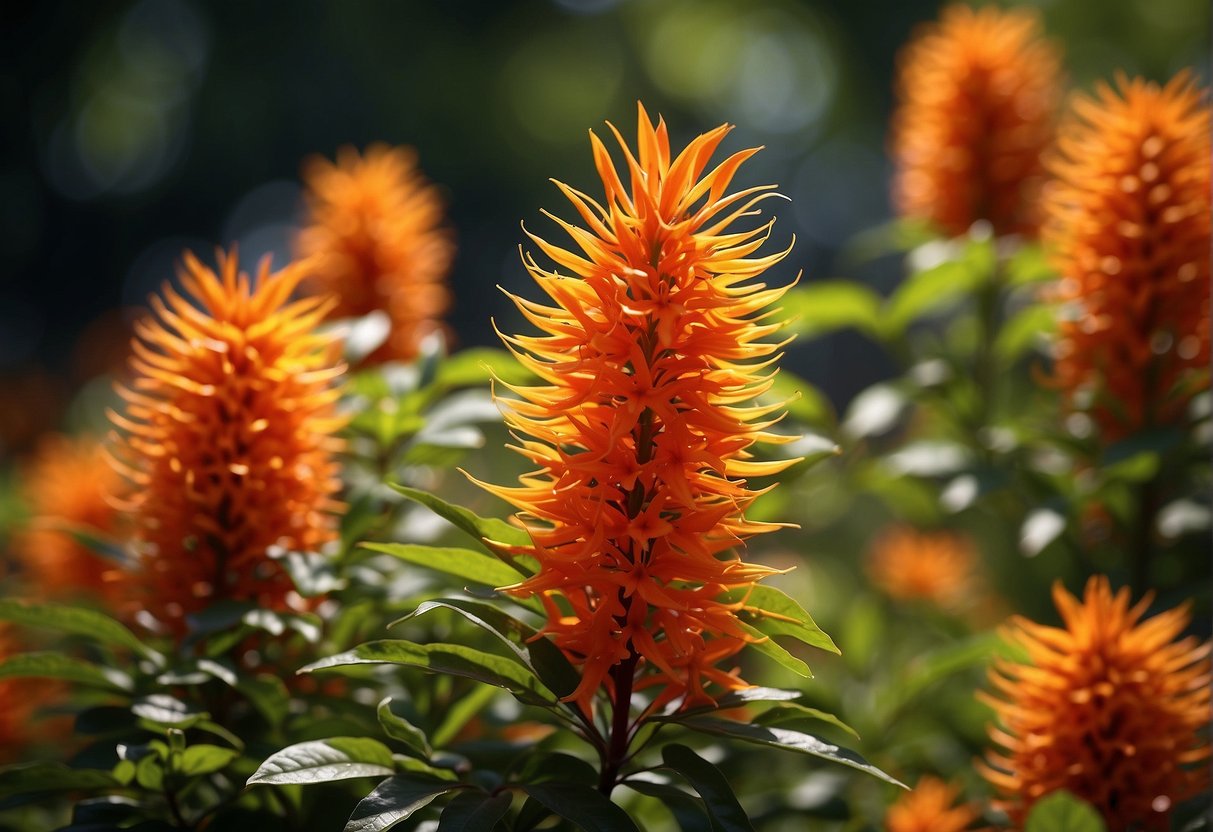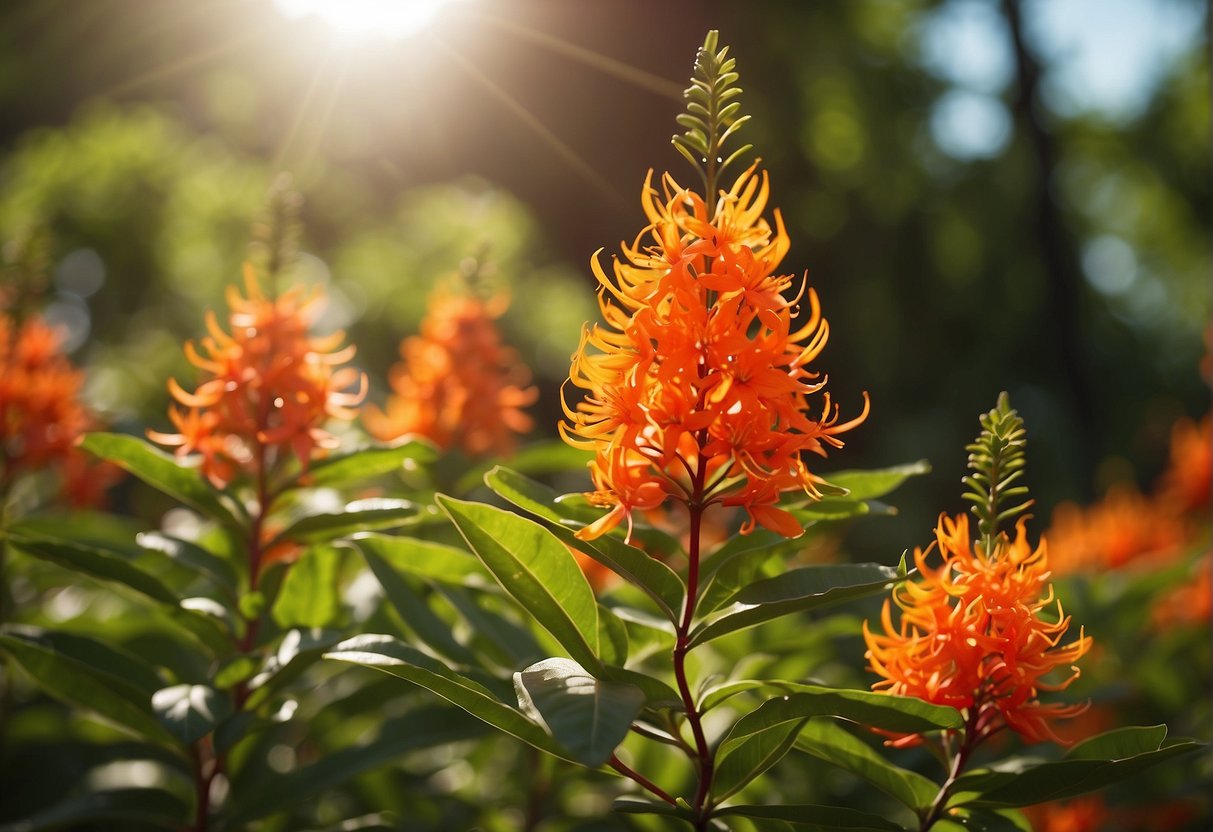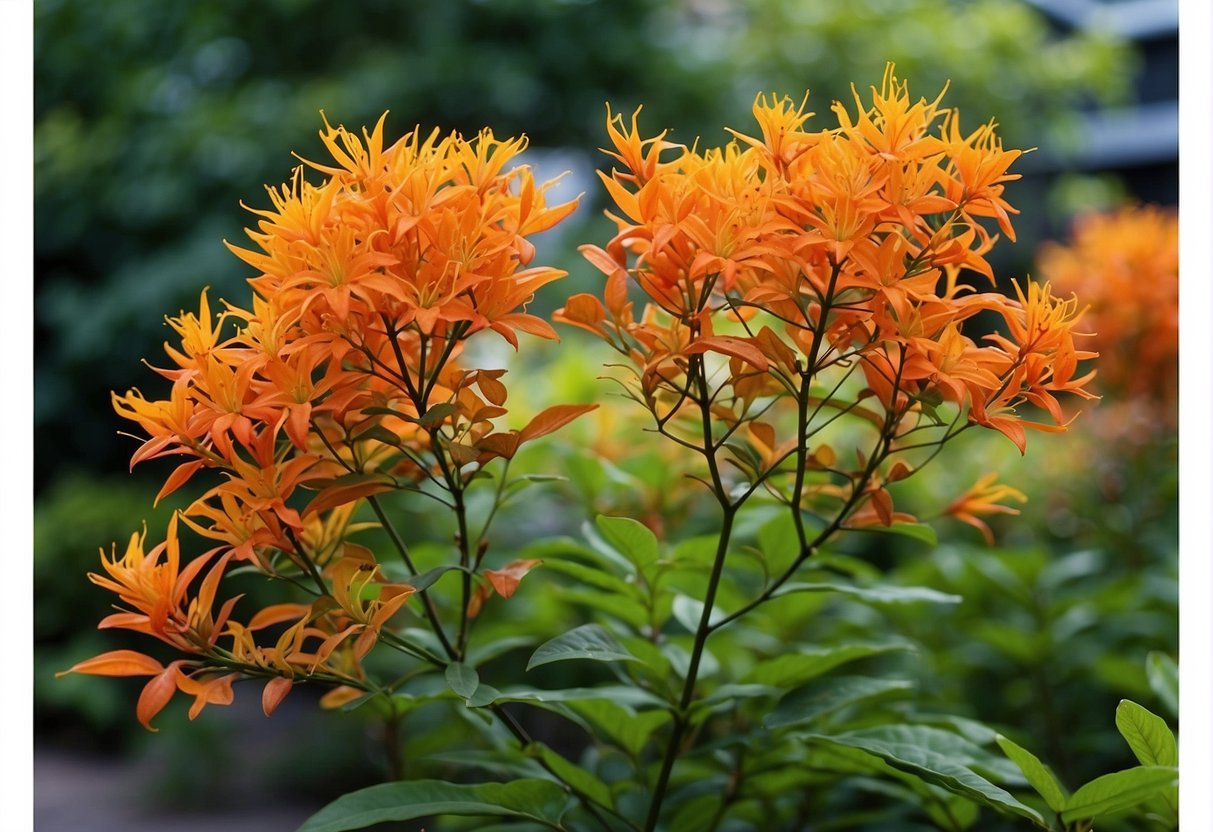What is Firebush? A Guide to the Plant’s Characteristics and Uses
Should you be in the market for a visually appealing, easy-to-care-for shrub that brings vibrancy to your outdoor space, the firebush (Hamelia patens) could be an ideal choice. This tropical plant is celebrated for its vivid red-orange blooms that grace warm climates year-round. Beyond its beauty, the firebush is valued for its capacity to draw in wildlife such as hummingbirds and butterflies.

Firebush is a member of the coffee family (Rubiaceae) and is native to Central and South America. It can grow up to 15 feet tall in the wild, but in cultivation it is usually kept smaller, around 4-6 feet. The plant has shiny, dark green leaves that are about 4 inches long, and its flowers are tubular and about an inch long. Firebush is also known by several other common names, including scarlet bush, redhead, and hummingbird bush.
Key Takeaways
- Firebush is a tropical shrub with red-orange flowers that bloom throughout the year in warm climates.
- The plant is a member of the coffee family and is native to Central and South America.
- Firebush is popular for attracting wildlife, including hummingbirds and butterflies.
Botanical Profile
Taxonomy
Firebush, scientifically known as Hamelia patens, is a woody shrub belonging to the Rubiaceae family. It is native to the tropical regions of the Americas, including Florida, the Caribbean, Mexico, and South America. Firebush is also commonly known as scarlet bush, hummingbird bush, and firecracker plant.
Physical Characteristics
Firebush is a fast-growing shrub that can reach up to 10 feet in height and 6 feet in width. It has a multi-stemmed growth habit and produces numerous branches that form a dense, bushy canopy. The foliage of firebush is evergreen and consists of simple, elliptical leaves that are 2-6 inches long and 1-2 inches wide. The leaves are dark green and glossy on the upper surface, while the lower surface is pale green and slightly hairy.
The flowers of firebush are tubular and bright red-orange in color, with a yellow-orange throat. They are produced in clusters at the ends of the branches and attract a variety of pollinators, including hummingbirds and butterflies. The fruit of firebush is a small, round, black berry that is edible but not commonly consumed by humans.
Firebush is a popular ornamental plant due to its attractive foliage and showy flowers. It is commonly used in landscaping as a hedge, border, or specimen plant. Firebush is also used in traditional medicine for a variety of ailments, including fever, diarrhea, and skin infections. However, further research is needed to determine the efficacy and safety of these uses.
Cultivation

Planting Instructions
To grow firebush, you will need to start by selecting a suitable planting location. Firebush is native to Central and South America, and it thrives in well-drained soil. When planting, make sure to dig a hole that is twice as wide as the root ball. Gently remove the plant from its container and place it in the hole. Fill the hole with soil, and water the plant thoroughly.
Soil Preferences
Firebush prefers well-drained soil that is moist but not waterlogged. It can grow in a range of soil types, including sandy, loamy, and clay soils. However, the plant does not do well in heavy, poorly drained soils.
Sunlight Requirements
Firebush requires full sun to thrive. It can tolerate partial shade, but it may not flower as well in shaded areas. When planting, make sure to select a location that receives at least six hours of direct sunlight per day.
Water and Moisture
Firebush is drought-tolerant, but it still requires regular watering to thrive. Water the plant deeply once a week, or more often during periods of extreme heat or drought. Make sure to avoid overwatering, as this can lead to root rot. In addition, firebush prefers a humid environment, so it may benefit from occasional misting.
Varieties and Hybrids

Hamelia Patens Var. Glabra
Hamelia Patens Var. Glabra, also known as the glabra firebush, is a variety of firebush that is native to Mexico and Central America. It is a compact, evergreen shrub that can grow up to 10 feet tall. The glabra firebush has smooth, glossy leaves and produces clusters of tubular, orange-red flowers that attract hummingbirds and butterflies. This variety of firebush is well-suited for use as a hedge or screen.
Hamelia Patens Var. Patens
Hamelia Patens Var. Patens, also known as the patens firebush, is a variety of firebush that is native to Florida, the Caribbean, and South America. It is a fast-growing, deciduous shrub that can reach up to 15 feet tall. The patens firebush has hairy, lance-shaped leaves and produces clusters of tubular, red-orange flowers that attract hummingbirds and butterflies. This variety of firebush is well-suited for use as a specimen plant or in a mixed border.
Dwarf Firebush
The dwarf firebush, also known as compacta firebush, is a hybrid variety of firebush that is a cross between Hamelia Patens Var. Glabra and Hamelia Patens Var. Patens. It is a small, compact shrub that grows up to 3 feet tall and wide. The dwarf firebush has smooth, glossy leaves and produces clusters of tubular, orange-red flowers that attract hummingbirds and butterflies. This variety of firebush is well-suited for use in containers, as a low hedge, or as a groundcover.
Whether you choose the glabra firebush, patens firebush, or dwarf firebush, all varieties of firebush are easy to care for and provide a burst of color to any landscape.
Seasonal Behavior
Firebush is a deciduous shrub that exhibits seasonal changes in its appearance and behavior. Understanding its seasonal behavior can help you care for it better and enjoy its beauty throughout the year.
Flowering Period
Firebush blooms in the late spring and continues to bloom throughout the summer and into the fall. During this time, its branches are covered with clusters of tubular flowers that attract hummingbirds and butterflies.
Fruiting Period
After the blooming period, firebush produces small, red berries that persist into the fall. These berries are a valuable food source for birds and other wildlife.
During the winter, firebush loses its leaves and becomes dormant. However, it is important to note that firebush is a late bloomer, meaning it may not show signs of new growth until later in the spring than other plants.
To ensure that your firebush thrives, it is important to provide it with proper care during each season. In the summer, make sure it receives enough water and sunlight to support its blooming and fruiting periods. In the fall, you can prune it back to promote healthy growth in the following year.
Overall, firebush is a beautiful and resilient shrub that can enhance the beauty of your garden throughout the year. By understanding its seasonal behavior and providing it with proper care, you can enjoy its blooms and berries for years to come.
Environmental Adaptations
Firebush is a highly adaptable plant that can thrive in a variety of environmental conditions. In this section, we will explore the temperature tolerance, drought resistance, and soil type adaptability of firebush.
Temperature Tolerance
Firebush is a heat-loving plant that can tolerate high temperatures and full sun exposure. It can withstand temperatures as high as 100°F (38°C) and can grow in USDA hardiness zones 8 to 11. However, firebush is not frost-tolerant and cannot survive in areas with temperatures below 30°F (-1°C).
Drought Resistance
Firebush is a drought-tolerant plant that can survive in sandy and dry soils. It can withstand long periods of drought and can recover quickly after a drought period. However, firebush requires regular watering during its initial growth period to establish a healthy root system.
Soil Type Adaptability
Firebush can adapt to a wide range of soil types, including sandy, loamy, and clay soils. It prefers well-drained soils but can tolerate soils with poor drainage. Firebush can also tolerate salt spray and can grow in coastal areas.
In summary, firebush is a highly adaptable plant that can thrive in hot and dry environments. It can withstand high temperatures, drought, and a variety of soil types. With proper care and maintenance, firebush can be a beautiful addition to any landscape.
Wildlife Attraction
Firebush is a great addition to any garden or landscape if you are looking to attract wildlife. Here are some of the ways in which this native plant can help you attract pollinators and birds to your garden.
Attracting Pollinators
Firebush is a great source of nectar for pollinators such as bees, butterflies, and hummingbirds. The bright red flowers of the firebush are particularly attractive to hummingbirds, and they will often visit the plant several times a day to feed on the nectar. Bees and butterflies are also attracted to the flowers and will help to pollinate other plants in your garden.
Bird-Friendly Qualities
Firebush is a great plant for attracting birds to your garden. The berries of the firebush are a favorite food of many bird species, including the Eastern Bluebird, American Robin, and Northern Mockingbird. The plant also provides a great source of shelter and nesting material for birds.
If you are looking to attract birds to your garden, planting firebush is a great way to do so. The plant is also a great addition to any garden or landscape if you are looking to attract pollinators such as bees, butterflies, and hummingbirds. With its bright red flowers and bird-friendly qualities, firebush is a must-have for any wildlife garden.
Care and Maintenance
Taking care of firebush is relatively easy, and with proper maintenance, it can thrive for years to come. Here are some essential tips to keep in mind:
Pruning Practices
Pruning is an essential part of caring for your firebush. It helps to maintain its shape, promote healthy growth, and prevent the plant from getting too leggy. You should prune your firebush at least once a year, preferably in early spring before new growth appears.
To prune your firebush, use sharp and clean pruning shears, and make cuts just above a node or leaf. Remove any dead or diseased branches, as well as any crossing or rubbing branches. You can also prune your firebush to control its size and shape, but avoid cutting back more than a third of the plant at once.
Propagation Methods
Firebush can be propagated through cuttings, which is a simple and cost-effective way to grow new plants. To propagate your firebush, take a 4-6 inch cutting from a healthy and mature plant, and remove the lower leaves. Dip the cut end in rooting hormone powder and plant it in a well-draining potting mix. Water the cutting and cover it with a plastic bag to create a humid environment. Place the pot in a bright and warm spot, but avoid direct sunlight. The cutting should root in a few weeks, and you can transplant it to a larger pot or the garden.
Pest and Disease Management
Firebush is relatively resistant to pests and diseases, but it can be affected by mites, aphids, and scale insects. To prevent infestations, keep your firebush healthy and well-watered, and avoid over-fertilizing. If you notice any pests, you can spray your plant with a solution of neem oil or insecticidal soap.
Firebush can also be affected by fungal diseases, such as powdery mildew and root rot. To prevent these diseases, avoid overwatering and provide good air circulation around your plant. If you notice any signs of fungal infection, such as yellowing leaves or white powdery patches, remove the affected parts and treat your plant with a fungicide.
In conclusion, caring for firebush is relatively easy, and with proper maintenance, it can thrive for years to come. By following these tips, you can keep your firebush healthy, beautiful, and pest-free.
Landscape Uses
Firebush is a versatile shrub that can be used in a variety of landscape settings. Here are some common ways to incorporate this plant into your garden:
Hedging and Borders
Firebush is an excellent choice for creating hedges and borders. Its dense growth habit and small, glossy leaves make it an attractive and effective screen. Plant firebush in a row to create a natural fence that will provide privacy and block out unwanted views. You can also use firebush as a border plant to define garden beds and walkways.
Container Gardening
Firebush is a great plant for container gardening. Its compact size and attractive tubular flowers make it a popular choice for patio pots and other containers. Plant firebush in a pot with well-draining soil and place it in a sunny location. Water regularly and fertilize with a balanced fertilizer to keep it healthy and blooming.
Specimen Planting
Firebush is a beautiful plant that can be used as a specimen planting in your garden. Its vibrant red-orange flowers and glossy leaves make it a standout plant that will draw attention. Plant firebush in a prominent location where it can be appreciated as a focal point. You can also use firebush in mixed borders with other plants to add color and texture.
Overall, firebush is a versatile and attractive plant that can be used in a variety of landscape settings. Whether you’re looking to create a hedge, plant in a container, or use as a specimen plant, firebush is a great choice that will provide years of beauty and enjoyment.
Additional Information
Cultural Significance
Firebush is not only a beautiful plant, but it also has cultural significance in some parts of the world. In Mexico, it is known as “cigarro de rey” or “king’s cigar” and is used in traditional medicine to treat a variety of ailments. The plant is believed to have anti-inflammatory, antiseptic, and diuretic properties.
In addition to its medicinal uses, firebush is also used in traditional ceremonies in some cultures. It is believed to have spiritual properties and is used to ward off negative energy and attract positive energy.
Conservation Status
Firebush is not currently listed as an endangered species, but it is important to be mindful of its conservation status. As with any plant, over-harvesting or destruction of its natural habitat can have negative impacts on the species.
If you are interested in growing firebush in your garden, consider purchasing plants from reputable nurseries that practice sustainable growing methods. Additionally, be sure to properly care for your plants to ensure their long-term health and vitality.
Overall, firebush is a fascinating and beautiful plant with a rich cultural history. Whether you are interested in its medicinal properties or simply appreciate its aesthetic value, there are many reasons to consider adding this tropical plant to your garden.
Frequently Asked Questions
What are the medicinal properties of firebush?
Firebush, also known as Hamelia patens, has been used in traditional medicine for various ailments. The plant contains compounds such as quercetin and kaempferol, which have been found to have anti-inflammatory and antioxidant properties. Some traditional uses of firebush include treating fever, diarrhea, and respiratory infections. However, more research is needed to fully understand the potential medicinal benefits of firebush.
Can you eat the fruit of the firebush plant?
While the fruit of the firebush plant is technically edible, it is not commonly consumed by humans. The fruit is small and contains numerous seeds, which can make it difficult to eat. Additionally, the fruit is not particularly flavorful and is often used as a food source for wildlife instead.
What are the different cultivars of firebush available?
There are several cultivars of firebush available, each with slightly different characteristics. Some popular cultivars include Hamelia patens ‘Compacta’, which is a smaller and more compact version of the plant, and Hamelia patens ‘Lime Sizzler’, which has variegated foliage. Other cultivars may have different flower colors or growth habits.
How can firebush benefit local wildlife and pollinators?
Firebush is an excellent plant for attracting wildlife and pollinators to your garden. The plant produces bright red or orange tubular flowers that are a favorite of hummingbirds and butterflies. Additionally, the plant’s fruit provides a food source for birds and small mammals.
Is there a difference between firebush and hummingbird bush?
Firebush and hummingbird bush are two different common names for the same plant, Hamelia patens. Both names refer to the plant’s ability to attract hummingbirds with its bright flowers.
What are the preferred growing conditions for firebush?
Firebush is a tropical plant that prefers warm, humid conditions. It grows best in full sun or partial shade and requires well-draining soil. The plant is drought-tolerant once established, but will benefit from regular watering during dry periods.


